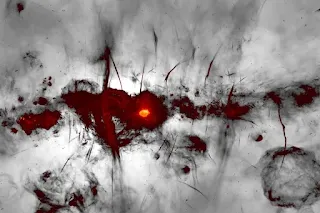Stunning view of the Milky Way reveals mysterious shapes hanging in space
The new MeerKAT image of the Galactic center region is shown with the Galactic plane running horizontally across the image. Many new and previously-known radio features are evident, including supernova remnants, compact star-forming regions, and the large population of mysterious radio filaments. The broad feature running vertically through the image is the inner part of the (previously discovered) radio bubbles, spanning 1400 light-years across the center of the Galaxy. Colors indicate bright radio emission, while fainter emission is shown in grayscale. Credit: I. Heywood, SARAO.
A team of researchers from Northwestern University in the United States captured new images using the high-sensitivity radio telescope "MeerKAT" at the South African Radio Astronomy Observatory (SARAO), and these images reveal mysterious shapes in the heart of our galaxy (the Milky Way).
According to the university's press release issued on January 26, these images show about a thousand groups of mysterious threads suspended incomprehensiblely in space with unprecedented clarity. These strings, which cover up to 150 light-years, are found in organized groups, some of which consist of only two strings and some of which contain several strings separated by equal distances, as if they were strings in a fugitive machine.
These organized magnetic strands have been a mystery since the eighties of the last century, when they were first discovered by astrophysicist Farhad Yousefzadeh of this university. He noted that these filaments include cosmic ray electrons and rotate in the magnetic field at speeds approaching the speed of light.
But the new image, taken using the Meerkat telescope, shows 10 times the threads that Youssefzadeh observed in the previous study. This information may help him unravel the mystery of this mystery that has baffled scientists for decades.
Regarding the latest discovery, Youssefzadeh, head of the research team of the latest study, says in the university's press release, "We were finally able to see the whole picture, which was a panoramic view full of threads. It is difficult to reach real conclusions about what these threads are, their origin and source by just examining a few Threads only.
A report published on the "Science Alert" website indicates that the center of the Milky Way, where the mysterious shapes are located, is surrounded by thick clouds of gases that block some wavelengths of light, including the visible spectrum, and therefore it is impossible to see through it.
The Meerkat telescope at the South African Radio Astronomy Observatory is one of the most advanced radio telescopes in the world. Since its launch, it has allowed us to see never-before-seen sights at the center of our galaxy.
Supernova remnants and other things
To construct this new image with unprecedented clarity, astronomers spent 3 years probing the depths of space and analyzing data at the Radio Astronomy Observatory in South Africa. The researchers collected images during 200 hours of observation through the Meerkat telescope of different sections of the sky near the center of the galaxy, which is 25,000 light years from Earth. Then Yousefzadeh and his team used a background masking technique from the images to highlight magnetic strands scattered at the center of the galaxy.
The new data reveals the remnants of a previously undiscovered supernova, but the radiation emitted by the filaments is very different from that emitted by a supernova. This indicates that each of the two phenomena has a different source. It is likely that these filaments are related to previous activity of the giant black hole in the center of the galaxy, or perhaps to the huge bubbles emitting radio waves that Youssefzadeh discovered in the heart of the Milky Way in 2019.
The complex, cirrus-like emission from the Galactic center super bubble dominates this image. This is traversed by the Radio Arc, a complex of many parallel radio filaments. The radio bubble nestles against the diffused Sagittarius A region in the lower center of the image. The bright dot near the center of this region is Sagittarius A*, a 4 million solar mass black hole. This image captures the chaotic complexity of the very heart of our Galaxy. Credit: I. Heywood, SARAO.The Meerkat Wireless Telescope showed never-before-seen views of the Milky Way (South African Radio Observatory)
"This is the first time that we have been able to study the statistical features of these filaments, and this will allow us the opportunity to learn more about the properties of their unusual sources," says the astrophysicist.
The new image showed that these threads are distributed in the form of clusters or groups, separated by equal distances, equivalent to the distance between the Earth and the Sun.
Youssefzadeh and his team do not know whether these filaments move or change over time, or what causes the electrons to accelerate so quickly inside these magnetic filaments. It may have something to do with the strange magnetic filaments that were discovered last year.
The astrophysicist concludes, "We are certainly a step closer to understanding these leads, but scientific discoveries are a set of achievements on different levels."
Tags:
cambridge science
electrical sciences
genomic sciences
geosciences
life science
live science
neuroscience
science
science magazine
space science
strait of science



